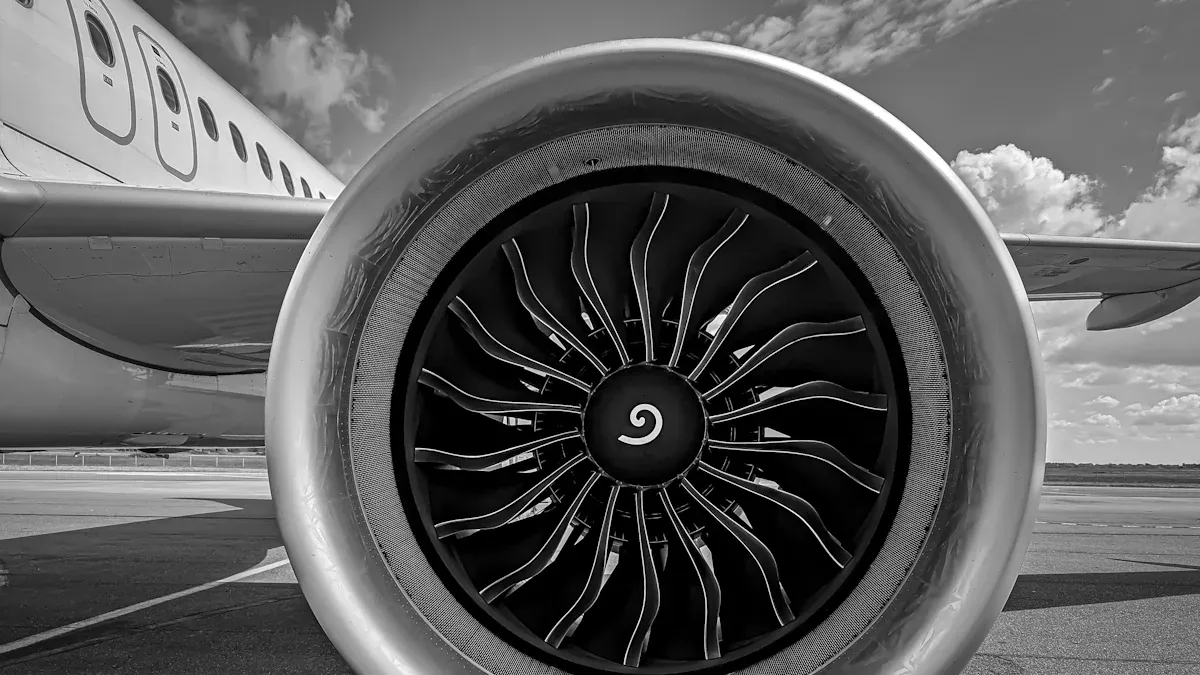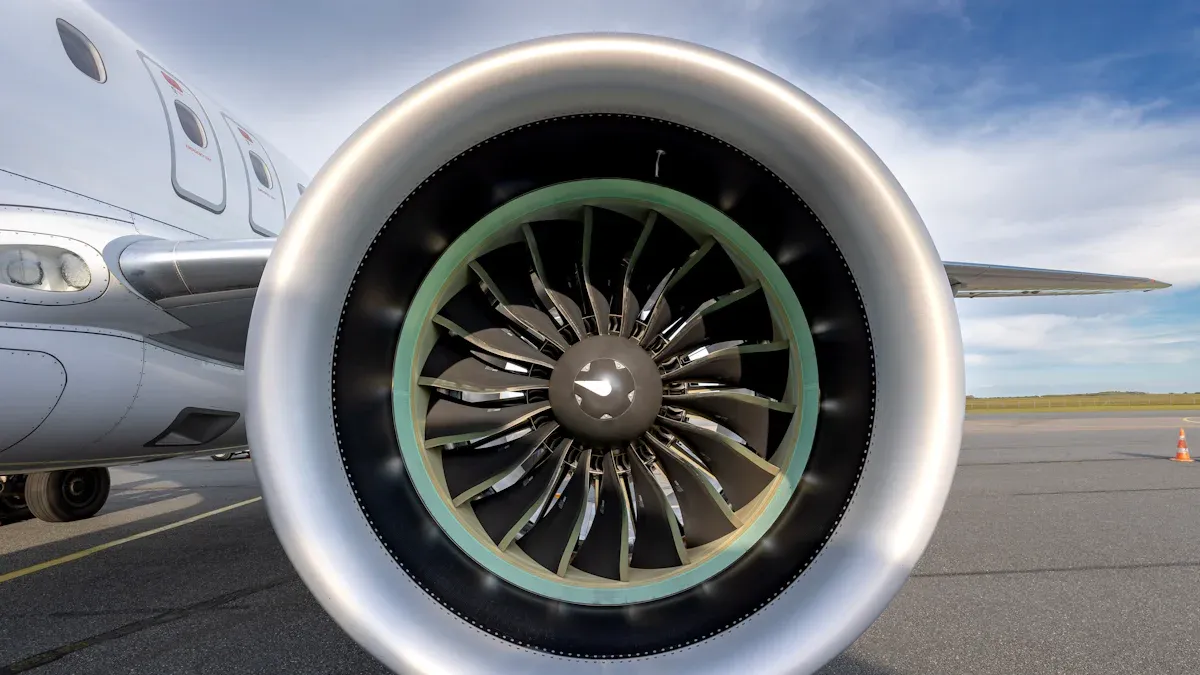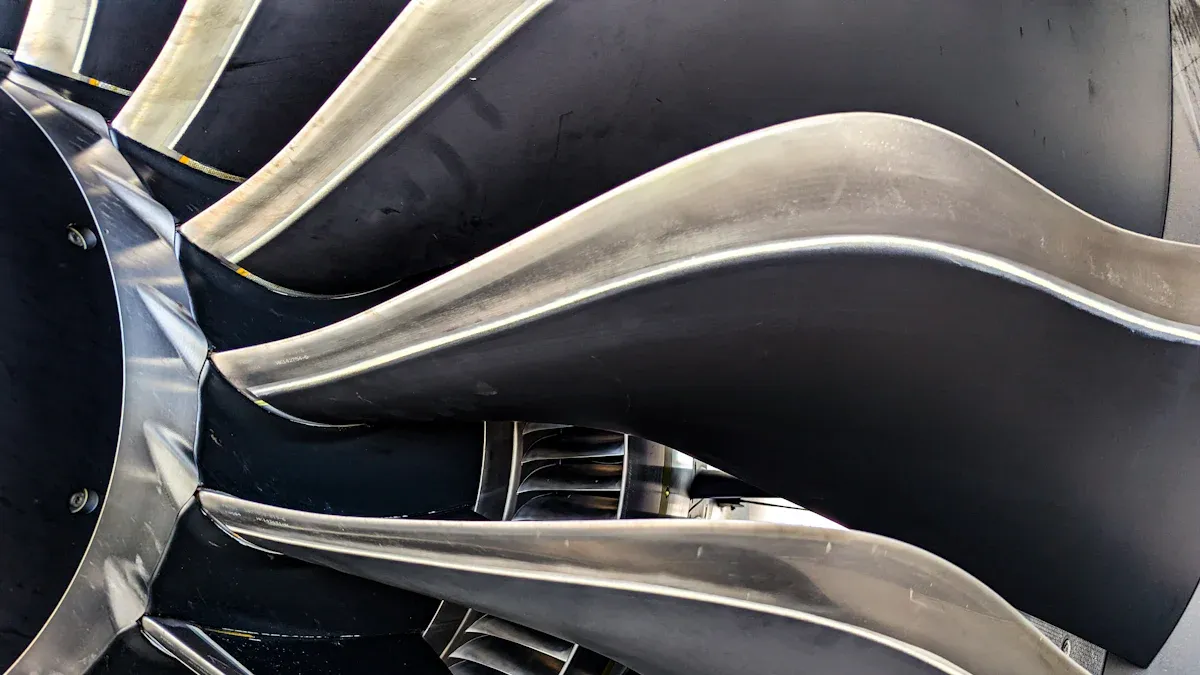
Aerospace turbine blades face extreme conditions during operation. They must endure intense heat, high-speed friction, and exposure to corrosive environments. SiC coating offers an innovative solution to these challenges. Its thermal resistance and durability make it ideal for protecting turbine blades from wear and oxidation. The best SiC coating enhances engine reliability while reducing maintenance needs. Manufacturers in a sic coating factory use advanced methods to ensure consistent performance. This technology is transforming how aerospace engines operate under harsh conditions.
Key Takeaways
- SiC coatings shield turbine blades from heat, rust, and damage. This helps them work better and last longer.
- These coatings let blades handle hotter temperatures. Engines become 20% more efficient and use less fuel.
- SiC coatings cut down on repairs, saving money fast. Most savings happen in two years.
- SiC coatings are light, so they reduce strain on parts. This improves engine power and performance.
- Using SiC coatings helps the planet. They lower harmful gases and shrink aerospace pollution.
Challenges in Aerospace Turbine Blade Protection
High Temperatures and Thermal Stress
Aerospace turbine blades operate in extreme heat, often exceeding 1,300°F (715°C). This intense environment creates significant thermal stress, which can lead to material fatigue and failure. Repeated thermomechanical loading causes cracks to form due to thermal fatigue. Nickel-based superalloys, commonly used in turbine blades, perform well under high temperatures but still face challenges like inelastic strain caused by centrifugal forces. Engineers incorporate cooling channels and thermal barrier coatings to manage heat, yet temperature gradients continue to create thermal stresses that accelerate crack growth. Persistent high temperatures also lead to creep, a phenomenon where materials deform over time, further compromising blade integrity.
Oxidation and Corrosion in Extreme Environments
Turbine blades face constant exposure to corrosive elements, such as sulfur and sodium compounds, in high-temperature environments. This exposure leads to oxidation and sulfidation, which weaken the protective coatings and underlying materials. The progression of corrosion can be broken into four stages:
- Light sulfidation with minor coating deterioration.
- Advanced scale breakdown and surface roughness.
- Severe sulfidation with significant mechanical integrity loss.
- Catastrophic failure due to deep penetration of the base metal.
These stages highlight the importance of robust protective measures. Traditional materials like nickel-chromium alloys offer some resistance, but advanced solutions like sic coating provide superior protection against oxidation and corrosion.
Wear and Erosion from High-Speed Operation
High-speed operation subjects turbine blades to wear and erosion, particularly along the leading edges. This erosion reduces aerodynamic efficiency and can lower energy production by up to 5% annually. Structural fatigue often develops at stress points, such as the blade root and transition zones, due to cyclic loading. Engineers face the challenge of designing blades that maintain aerodynamic performance while resisting environmental damage. Retrofitting older blades with protective coatings can extend their lifespan and improve efficiency. Advanced computational tools, such as Pseudo-Direct Numerical Simulation (P-DNS), now help predict erosion damage and optimize blade designs for durability.
The Science Behind SiC Coatings

What makes silicon carbide (SiC) unique
Silicon carbide (SiC) stands out due to its remarkable ability to endure extreme conditions. Its high melting point, exceeding 1,600°C, makes it suitable for environments where traditional materials fail. SiC coatings are widely used in aerospace because they resist radiation and maintain performance in vacuum conditions. This chemical stability allows SiC to withstand harsh environments without degrading. These qualities make it an ideal choice for protecting turbine blades in high-temperature and corrosive settings.
SiC also offers exceptional strength characteristics. It enhances the reliability and service life of aerospace components, even under intense mechanical stress. Manufacturers increasingly adopt SiC ceramic composites to meet strict environmental regulations while improving energy efficiency.
Key properties: thermal resistance, durability, and lightweight nature
SiC coatings excel in three critical areas: thermal resistance, durability, and lightweight design. Their thermal conductivity allows them to transmit heat 100 times faster than glass, ensuring efficient heat management. This property helps turbine blades maintain structural integrity at extreme temperatures.
Durability is another key advantage. SiC coatings resist cracking and environmental degradation, as shown by their high fracture toughness and chemical durability. These attributes ensure long-term performance, even in the most demanding conditions.
Lightweight nature further sets SiC apart. Its high stiffness-to-mass ratio (elastic modulus) makes it more efficient than traditional materials like nickel-based superalloys. This combination of properties reduces the overall weight of turbine components, improving engine efficiency and performance.
| Metric | Description |
|---|---|
| Thermal Conductivity | Transmits heat 100x faster than glass |
| Flexural Strength | More efficient for lightweight applications |
| Elastic Modulus | High stiffness-to-mass ratio |
| Fracture Toughness | Resistance to cracking under stress |
| Chemical Durability | Withstands environmental degradation |
How SiC coatings mitigate turbine blade challenges
SiC coatings address the primary challenges faced by turbine blades, including extreme heat, oxidation, and wear. Their thermal resistance allows blades to operate at higher temperatures without compromising structural integrity. This capability improves energy efficiency by up to 20% compared to traditional materials.
The chemical stability of SiC prevents oxidation and corrosion, ensuring long-term protection in high-temperature environments. This resistance reduces the need for frequent maintenance, lowering operational costs. Additionally, the lightweight nature of SiC coatings minimizes stress on turbine components, extending their lifespan.
By combining these properties, SiC coatings provide a comprehensive solution for enhancing the performance and durability of aerospace turbine blades.
SiC Coatings vs. Traditional Materials
Comparison with nickel alloys and thermal barrier coatings
Nickel alloys and thermal barrier coatings have been the standard materials for turbine blade protection. Nickel alloys offer good heat resistance and strength, while thermal barrier coatings provide insulation against extreme temperatures. However, both materials have limitations. Nickel alloys can suffer from oxidation and creep at high temperatures. Thermal barrier coatings, while effective, may degrade over time due to thermal cycling and environmental exposure.
SiC coatings outperform these traditional materials in several ways. Their higher melting point and chemical stability allow them to endure harsher conditions. Unlike nickel alloys, SiC coatings resist oxidation and corrosion more effectively. They also maintain their structural integrity under prolonged thermal stress, making them a superior choice for aerospace applications.
Superior performance in thermal resistance and durability
SiC coatings excel in thermal resistance and durability. Their ability to withstand temperatures exceeding 1,600°C ensures reliable performance in extreme environments. This property allows turbine blades to operate at higher temperatures, improving engine efficiency. Additionally, SiC coatings resist cracking and wear, even under intense mechanical stress. This durability reduces the risk of failure and extends the lifespan of turbine components.
In contrast, traditional materials like nickel alloys and thermal barrier coatings often require frequent maintenance. Their susceptibility to thermal fatigue and environmental degradation limits their long-term effectiveness. SiC coatings provide a more robust solution, ensuring consistent performance over time.
Cost-effectiveness and reduced maintenance needs
SiC coatings offer significant cost benefits. Their enhanced thermal conductivity allows engines to operate at higher temperatures with reduced cooling requirements. This leads to energy savings of up to 30%. The durability of SiC coatings minimizes the need for frequent replacements, lowering maintenance costs. Although the initial investment in SiC technology may be higher, the return on investment is quick, often within two years. This makes SiC coatings a cost-effective choice for aerospace applications.
By reducing operational costs and extending component life, SiC coatings provide both economic and performance advantages. Their adoption represents a shift toward more efficient and sustainable aerospace technologies.
Application and Development of SiC Coatings

Methods for applying SiC coatings to turbine blades
Applying SiC coatings to turbine blades requires precision and advanced techniques. Manufacturers use innovative methods to ensure the coatings adhere effectively and perform under extreme conditions. Hybrid components integrate the coating and substrate materials, creating seamless structures that enhance durability. Nanostructures, with layer thicknesses ranging from 1 to 1,000 nanometers, improve thermal resistance and performance in steep temperature gradients. Interface control focuses on stabilizing the junction between the substrate and coating, ensuring reliability in high-temperature environments.
| Innovative Method | Description |
|---|---|
| Hybrid Components | Integration of coating and substrate materials, creating seamless structures. |
| Nanostructures | Coatings with layer thicknesses in the 1- to 1,000-nanometer range. |
| Interface Control | Stabilizing the substrate/coating junction for high-temperature reliability. |
These methods represent significant advancements in SiC coating technology, enabling turbine blades to operate efficiently in demanding aerospace applications.
Challenges in scaling up SiC coating applications
Scaling up SiC coating applications presents several challenges. The complexity of applying SiC coatings uniformly across large surfaces requires specialized equipment and expertise. High production costs limit widespread adoption, especially for smaller aerospace manufacturers. Maintaining consistent quality during mass production remains a critical issue. Variations in coating thickness or adhesion can compromise performance, leading to potential failures in high-stress environments.
Researchers are addressing these challenges by developing automated systems and refining deposition techniques. Innovations in plasma-enhanced processes and magnetron sputtering aim to reduce costs while improving scalability. These efforts are paving the way for broader implementation of SiC coatings in aerospace and other industries.
Innovations and ongoing research to enhance performance
Recent advancements in SiC coating technologies are driving improvements in performance and cost-effectiveness. Chemical Vapor Deposition (CVD) and Physical Vapor Deposition (PVD) methods have become more efficient, enabling the production of high-purity SiC coatings. Plasma-enhanced CVD and magnetron sputtering PVD offer enhanced precision and lower costs, making these techniques more accessible to manufacturers.
High-purity SiC coatings are now used in semiconductor wafer processing and high-intensity LED manufacturing, demonstrating their versatility and reliability. These innovations highlight the potential for SiC coatings to revolutionize aerospace turbine blade protection further. Ongoing research continues to refine these processes, ensuring that SiC coatings remain at the forefront of material science advancements.
Implications of SiC Coatings for Aerospace
Enhanced engine efficiency and performance
SiC coatings significantly enhance engine efficiency by enabling turbine blades to operate at higher temperatures. This capability improves the thermodynamic efficiency of engines, allowing them to generate more power with less fuel. The lightweight nature of SiC coatings also reduces the overall weight of turbine components, which further boosts engine performance. By maintaining structural integrity under extreme conditions, these coatings ensure consistent operation and reliability.
Higher operating temperatures also contribute to better thrust-to-weight ratios in aerospace engines. This improvement directly impacts the performance of aircraft, enabling them to achieve greater speeds and fuel efficiency. SiC coatings play a pivotal role in advancing aerospace technology by optimizing engine performance metrics.
Cost savings through extended component life
SiC coatings extend the lifespan of turbine blades by protecting them from wear, oxidation, and thermal stress. This durability reduces the frequency of maintenance and replacement, leading to significant cost savings. For example, SiC-coated turbine blades in GE Aviation’s GEnx engines achieve 15% better fuel efficiency while preventing approximately 23,000 tons of CO2 emissions annually per engine.
The table below highlights the cost-saving benefits across various industries:
| Industry | Evidence |
|---|---|
| Aerospace | SiC-coated turbine blades improve fuel efficiency and reduce emissions. |
| Steel Manufacturing | Heat exchangers with SiC coatings save 8-12% energy and recover 20% more heat. |
| Chemical Processing | Reactor vessels with SiC coatings extend service life by 60%, reducing steel waste significantly. |
These examples demonstrate the economic advantages of adopting SiC coatings in aerospace and beyond.
Environmental benefits from reduced emissions and fuel consumption
SiC coatings contribute to environmental sustainability by reducing fuel consumption and emissions. Their ability to withstand higher temperatures allows engines to operate more efficiently, which lowers fuel usage. This reduction directly translates to fewer greenhouse gas emissions.
Key environmental benefits include:
- Decreased engine weight, enhancing fuel efficiency.
- Lower fuel consumption, reducing carbon footprints.
- Higher operating temperatures, improving engine efficiency and reducing NOx emissions.
- Superior thrust-to-weight ratios, optimizing performance.
- Reduced emission of toxic gases, minimizing environmental impact.
By enabling cleaner and more efficient engine operations, SiC coatings support the aerospace industry’s efforts to achieve sustainability goals.
SiC coatings represent a transformative advancement in aerospace turbine blade protection. Their exceptional thermal stability and wear resistance make them ideal for components exposed to extreme operational conditions. These coatings enhance engine performance and extend component longevity, addressing critical challenges in aerospace engineering. By enabling higher efficiency and reducing maintenance needs, they contribute to cost savings and environmental sustainability. As research progresses, SiC coating technology will continue to shape the future of aerospace, ensuring engines operate reliably under the most demanding conditions.
FAQ
What are SiC coatings made of?
SiC coatings consist of silicon carbide, a compound of silicon and carbon. This material forms a ceramic coating that provides exceptional thermal resistance, durability, and chemical stability. Its unique properties make it ideal for protecting turbine blades in extreme aerospace environments.
How do SiC coatings improve turbine blade performance?
SiC coatings enhance turbine blade performance by resisting heat, oxidation, and wear. They allow blades to operate at higher temperatures, improving engine efficiency. Their lightweight nature reduces stress on components, extending their lifespan and ensuring reliable operation under harsh conditions.
Are SiC coatings environmentally friendly?
Yes, SiC coatings contribute to environmental sustainability. They enable engines to consume less fuel by improving efficiency. This reduces greenhouse gas emissions and lowers the carbon footprint of aerospace operations. Their durability also minimizes waste from frequent component replacements.
How are SiC coatings applied to turbine blades?
Manufacturers use advanced techniques like chemical vapor deposition (CVD) and physical vapor deposition (PVD) to apply SiC coatings. These methods ensure uniform application and strong adhesion, enabling the coatings to withstand extreme temperatures and mechanical stress.
What industries benefit from SiC coatings besides aerospace?
SiC coatings benefit industries like steel manufacturing, chemical processing, and electronics. They improve energy efficiency in heat exchangers, extend the lifespan of reactor vessels, and enhance the performance of semiconductor components. Their versatility makes them valuable across multiple sectors.